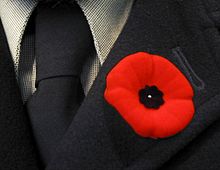Remembrance Poppy


As Remembrance Poppy ( German , memorial poppy ), also Poppy for short and Engl. The majority Remembrance Poppies are stylized artificial poppies in English-speaking countries , which today are considered to be a symbol of remembrance of the countless and nameless victims of war, and in particular of the soldiers who fell in the two world wars, around the world and especially in English-speaking countries . The use of the poppy flower ( Papaver rhoeas ) as a symbolic flower to commemorate war victims emerged in English-speaking countries in 1920 and initially served exclusively to commemorate fallen soldiers of the First World War .
In general, the term poppy is used in English-speaking countries both for the “real” poppy and for more or less lifelike artificial poppies - which are used for decorative purposes, etc.; in the narrower sense as remembrance poppy, however, only if mostly artificial poppies are used for commemorative purposes.
In particular, on Remembrance Day for the Dead of War , which in English-speaking countries is called Remembrance Day, also known as Poppy Day , and in the weeks before, symbolic artificial poppies are distributed in Great Britain and some other countries and worn on the lapel. The stylized boutonniere consist of a simplified replica of a poppy blossom, sometimes with a leaf. Often poppies are the memorials and graves resigned, mostly in the form of tagged artificial poppies mourning wreaths or - plugged- or else small wooden crosses or star or -halbmonde that with a single artificial poppy and often also with a short memorial Inscription are inserted into the earth or the lawn.
history
In the beginning, the poppy soon became a symbol in English-speaking countries after the First World War to commemorate the fallen soldiers. The poppy ( English poppy ) should - based on the poem " In Flanders Fields " by Canadian John McCrae to the - red from the blood of the soldiers of World War I. Fields of Flanders remember. In addition, the poppies began to bloom first on the newly raised hills of the soldiers' graves. In addition to the association with the red color of the blood of the fallen, the poppy in McCrae's poem is also interpreted in connection with the narcotic effects of the opium poppy ( Papaver somniferum ), from which morphine is obtained, which was used as a strong pain reliever for the seriously wounded soldiers.
In the British Empire (now Commonwealth of Nations ) established a national memorial to the First World War in 1920, the Remembrance Day or Poppy Day and partly Armistice Day (German: Armistice Day ) is called. In most English-speaking countries, as well as Belgium and France , this memorial day is November 11th.
The remembrance poppy was first proposed by the American Legion (Engl. American Legion ), a veterans organization of the US Army , from 1920 used to commemorate the 1914 to 1918 killed in World War American soldiers. The custom was then adopted by veterans' organizations in the British Empire, particularly in the United Kingdom , Canada , Australia and New Zealand . Today the Remembrance Poppy is mainly used in Great Britain and Canada to commemorate the soldiers who died in both world wars.
The custom is particularly widespread in Great Britain in the weeks leading up to and on Remembrance Day . During this time, Remembrance Poppies are sold there by the Royal British Legion as part of their Poppy Appeal and are often worn by public figures. However, the custom in Northern Ireland is controversial and most Irish nationalists and Irish Catholics refuse to wear a Remembrance Poppy due to the actions of the British Army during the Northern Ireland conflict.
Poppy meadow with blooming corn poppies ( Papaver rhoeas )
Trench with poppies, Dodengang in Diksmuide , West Flanders
Artificial poppies commemorate the dead of the world wars on Remembrance Day
Funeral wreaths made of artificial poppies, here at the Menenpoort war memorial in Ypres , West Flanders
Small memorial crosses made of wood, each with an artificial poppy and engl. Inscription "In Remembrance"
Artificial paper poppy used as a pin distributed by the Royal British Legion
Large plastic poppy on the Town Hall in Manchester
See also
literature
- Stacy Chambless: A memorial in scarlet. The poppy and the ritual of remembrance (= Pre-publications of the English Department of Odense University , Volume 130). Center for Engelsk, Odense (Denmark) 2004, (English).
- Niall Barr: Flanders Poppies and a "Brighter Britain". In: Niall Barr: The lion and the poppy. British veterans, politics, and society, 1921-1939. Praeger, Westport (Connecticut / USA) 2005, ISBN 0-313-32474-3 , pp. 85-116 (English).
- Ted Harrison: Remembrance Today. Poppies, Grief and Heroism. Reaction Books, London 2012, ISBN 978-1-7802-3052-8 ; also as an e-book, 2013: ISBN 978-1-7802-3044-3 (both in English).
Web links
- Poppies and Remembrance Project Britain, British Life and Culture, Mandy Barrow (English)
Individual evidence
- ↑ Rob Ruggenberg: The making of 'In Flanders Fields' . On the website The Heritage of the Great War / First World War 1914-1918 ; English, accessed July 2, 2013.
- ↑ a b Where did the idea to sell poppies come from? . On: BBC News website November 10, 2006; English, accessed July 2, 2013.
- ↑ Lisa Smyth: Thousands gather to remember war dead . In: The Belfast Telegraph, November 7, 2009; English, accessed July 2, 2013.







